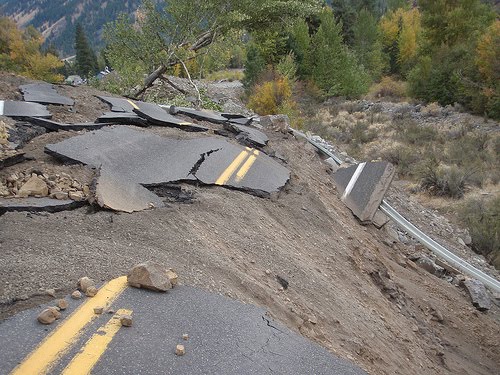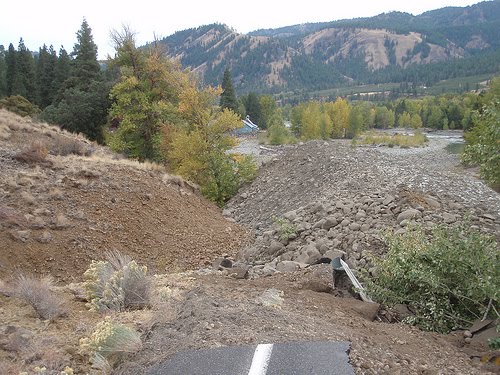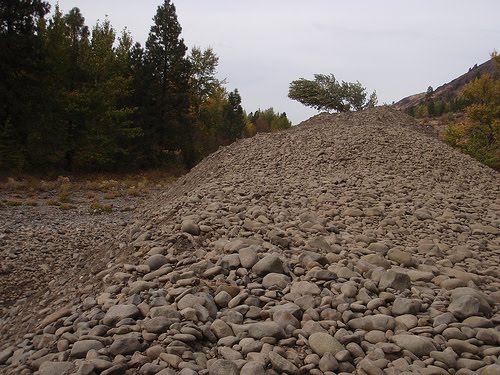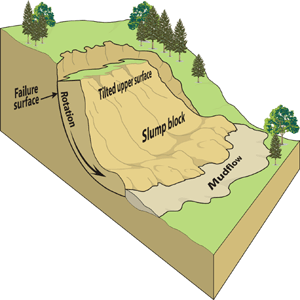13 October 2009
So what caused the Naches landslide?
Posted by Dave Petley
The Naches landslide, as I reported in my post yesterday, is a somewhat intriguing failure. The weather conditions were dry, the rivers are in low flow conditions, and there has not been an earthquake that could have caused the failure. So what happened?
A clue may be in the landslide type. Several reports have suggested that the initial failure was a rotational slide. I am struggling slightly to get a proper appreciation of the slide (does anyone know where there is a decent set of images taken from an aircraft or a helicopter?), but a quick inspection of the images from the galleries that Heidi posted in the comments from yesterday’s post is helpful. These three images, from this Washington State DoT gallery, are particularly helpful:
First, this one appears to show the highway uplifted well above the previous position (compare this with the Google Earth image here):

The second one appears to show the uplifted road and the gravels and cobbles from the river bed also uplifted well above the previous position:

Finally, this one also seems to show greatly uplifted river bed material:
 Some of the other images even show dead fish amongst this material, so there is not much doubt what this is.
Some of the other images even show dead fish amongst this material, so there is not much doubt what this is.
So how can the river bed be uplifted in this way by a landslide coming off the hillside. One possible explanation (lets call it a working hypothesis – I must stress that this is very tentative on the basis of the images) is that this is indeed a rotational slide. A typical rotational landslide looks like this (image from Geoscape Calgary):
 Notice how the movement has occurred on a curved surface – this is what makes the slide rotational. Notice also how material at the toe (foot) of the slide is lifted up due to the movement on the curved surface. Sometimes fragmentation of the blocks in this area causes flows to develop, but often this takes some time as the block starts to break up and weather. So, the uplifted road and riverbed is consistent with a rotational slide, although this is still only a hypothesis. In reality the images suggest that the slide is probably rather more complex than that shown above, but the essence may be a rotational failure.
Notice how the movement has occurred on a curved surface – this is what makes the slide rotational. Notice also how material at the toe (foot) of the slide is lifted up due to the movement on the curved surface. Sometimes fragmentation of the blocks in this area causes flows to develop, but often this takes some time as the block starts to break up and weather. So, the uplifted road and riverbed is consistent with a rotational slide, although this is still only a hypothesis. In reality the images suggest that the slide is probably rather more complex than that shown above, but the essence may be a rotational failure.
If that is the case, why did it fail. Well, for most rotational failures movement is the result one or more of three causes:
- The strength of the materials on the shear surface reduces. This is most likely to be the effect of rainfall causing high water pressures, although in this case that appears unlikely (although a leaking pipe or similar can sometimes be a factor). Materials sometimes degrade with time as well, causing a so-called progressive failure that usually has no trigger, so this is a possibility. If that is that is the case, and such failures are quite rare but definitely do occur, the slope should have shown lots of signs of problems for some time prior to failure;
- Mass is added to the slope at the top of the block that fails, which adds to the driving force, triggering failure. Sometimes dumping of spoil or garbage on the slope can trigger failures of this type. No such process is evident here, but it is possible.
- Mass was taken away from the toe of the slope. Much of the resistance to movement in a rotational slip comes from the material at the toe. Indeed, a common way to stabilise a rotational slide is to add mass the toe (often called a toe weight). A good example is the rotational landslide at Folkstone Warren in the UK (image from here):
 The huge structure at the bottom of the slope is a toe weight designed to buttress the slope to prevent a rotational failure, and thus to protect the railway line.
The huge structure at the bottom of the slope is a toe weight designed to buttress the slope to prevent a rotational failure, and thus to protect the railway line.
So, removal of the material at the toe (or low on the slope) could be enough to cause failure.
Therefore, if I was asked to look at this slide I would do the following:
- Work out what type of failure this is – i.e. is it a rotational slide?
- Find out whether there were any water pipes or suchlike on the slope that might have been leaking, or anything that might have been feeding water into the slope from above;
- See whether anyone had dumped a substantial amount of material high up on the slope;
- See whether anyone had removed material from low on the slope.
I know where my immediate suspicions would lie, but a proper investigation is needed. It may well be the case that the failure occurred because of a chain of events involving two or more of the possible causes outlines above.


 Dave Petley is the Vice-Chancellor of the University of Hull in the United Kingdom. His blog provides commentary and analysis of landslide events occurring worldwide, including the landslides themselves, latest research, and conferences and meetings.
Dave Petley is the Vice-Chancellor of the University of Hull in the United Kingdom. His blog provides commentary and analysis of landslide events occurring worldwide, including the landslides themselves, latest research, and conferences and meetings.
This area is part of a much larger landslide complex, the Sanford Pasture landslide. Zoom out on Google earth and you will see the scar that is Sanford Pasture–it extends some 6 miles to the southeast and involves much of the shallow bedrock on the southwest face of Cleman Mountain. Some interpretations of the geology suggest that much of the "bedrock" basalt on the opposite side of the river actually slid off Cleman Mountain.There are a number of "landslides-within-the-landslide" affecting Sanford Pasture. Ultimately the cause is a tectonic one. Cleman Mountain is an anticline (fold), and there are a number of weak sedimentary interbeds within the fairly steeply tilted section of basalts. As the river gradually cuts away at the toe, it is pretty easy for parts of the larger slide complex to reactivate. Possibly quarrying and road building on the landslide have some influence on the strength of the underlying materials, but the scale of the complex are such that failures are probably less predictable than more surficial landslides, i.e., more like earthquakes.
There are a few decent aerial shots in the photo gallery here:http://www.yakima-herald.com/stories/2009/10/11/massive-landslide-hits-state-route-410-and-naches-river
google maps is quite useful. As well as the overhead view there is pan, rotate and tilt view from the road as well.Nile Slide
Hi Dave – For some aerial shots, check out the Washington Department of Natural Resources website. In the middle of the page there's a smallish photo of the slide, and if you click it you can get into the gallery. It's possible people have dumped stuff, etc…running through your list of hypotheses, but I think that is doubtful. As far as moisture goes, above the slope there is a large bowl or basin-type area that supports a thick forest, so perhaps there's extra moisture up there.Cleman Mountain is an interesting mountain in that it is a very long mountain and is indeed a result of folding much like others down around the Yakima Valley, but up in the region of the slide and further northwest it joins up with the Cascade Mountains.Thank you for this blog.
What triggered the landslide? Officials are quick to discount the quarry, which had been approved for activity a few years ago after cracks had already been discovered. Serious thought needs to be given to how recently they had returned to excavating it.
The rock quarry did not trigger the slide. If anything it prevented 4 homes from being buried. I have lived in the Nile my entire life. I know there was a slide in 1956, before the rock quarry ever existing. The DNR has also taken rock off that hillside for road repairs and flood control. They took rock right next to the highway. I believe the river had a lot to do with this. I know that river has changed over the year getting deeper and deeper right at the toe of the mountain. I swam in that river every summer and watched our swimming hole, which is now 40ft in the air, get a couple feet deeper each year.
My son is a geotechnical engineer in WA. He was asked to look at the slide and observed an ice core like the one referenced in one of the previous blogs. I am a geologist who worked on permafrost in Alaska during construction of the Alyeska Pipeline. We routinely had access roads damaged by thawing cuts in ice rich loess and ice cored colluvium. Sie Muller was my professor at Stanford, the originator of the term "permafrost."
This is interesting. I went back and looked because of the recently discovered crack on Rattlesnake Ridge near union gap – Yakima Washing. It started in October 2017 and a drone flyover video shows incredible views. I think something very similar will happen soon there. Notice on the south side of the mountain an incredible amount of soil removed from the foot of the slope. Check it out. Another massive landslide is looming I think.
Interesting article. Geoinvestigate is involved on a slipped river bank subject to flooding near Worcester arising from several possible causes – adding fill weight to crest, driven displacement pile disturbance along crest, introducing water into slope by siting large unlined infiltration/soakaway pond behind crest with (leaking?) undersized segmental PVC outfall pipe leading down slope to unguarded river outfall where bank erosion has occurred corresponding with the toe of the shallow circular slip.
While all these water, weight & disturbance instability triggers are plain to see the forensic geotechnical expert investigating the loss prefers to totally ignore them? Whether this is negligence or fraud on their part has yet to be established and is a warning to geotechnical professionals about crossing the line.